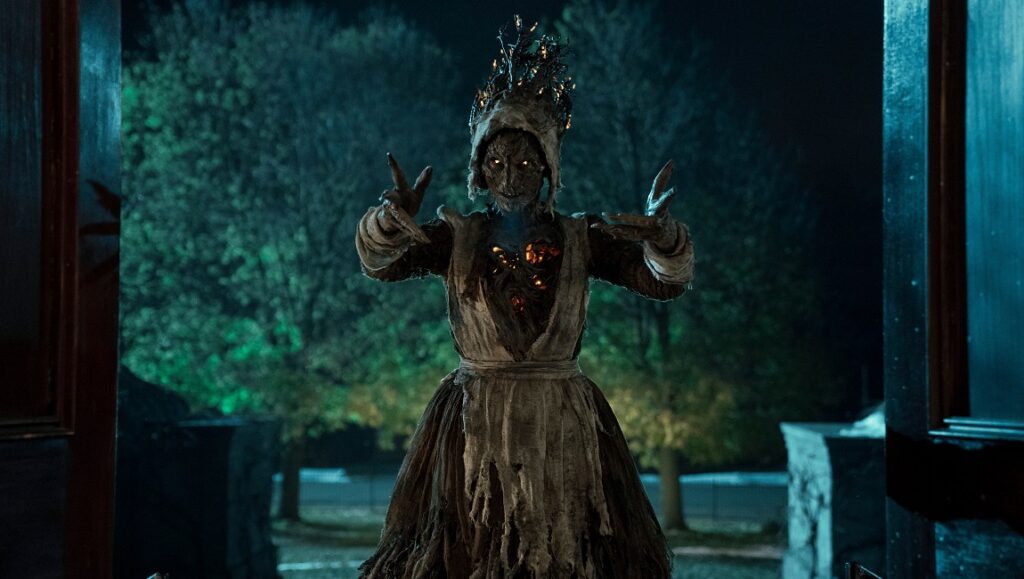Of the eight directors drafted to the roster of Guillermo del Toro’s Cabinet of Curiosities, Catherine Hardwick may be the oddest choice. Technically, she does have one feature horror film to her name — the ludicrous Red Riding Hood, which only succeeds in re-asserting the director’s facility with zeitgeisty indie soundtracks — but little else in her filmography recommends her for such a project. Her early career works include over-esteemed sub-Van Sant films like Thirteen and Lords of Dogtown, while the past decade is a hodgepodge of genre-jumping, including a low-budget erotic thriller (Plush), a generic rom-com-dram (Miss You Already), and an actioner remake (Miss Bala).
And then there’s the strange case of Twilight, a franchise Hardwicke commenced with a distinctly grimy oddball energy, spinning the relatively modest budget ($37 million; the final film in the series would cost $136 million) of this would-be tentpole film into a bizarrely lo-fi and entirely po-faced exercise in winceworthy YA angst. It’s the only film in her career that demonstrates any sense of real personality, and even if that amounts to what’s essentially a feature-length cringe compilation — the baseball sequence might be the most awkward few minutes in cinema history — that only a certain kind of viewer will be inclined to appreciate, it does suggest the potential for Hardwicke to thrive in the unapologetic genre territory of something like Cabinet of Curiosities.
She does not. Her contribution, “Dreams in the Witch House,” follows Walter (Rupert Grint), a man obsessed with reconnecting with his dead sister, Epperley. In the short’s opening sequence, Walter witnesses his sister dragged into some netherworld dubbed the Forest of Lost Souls upon her death, and as an adult he’s taken to traveling the world o’er to take in all manner of supernatural acts in hopes that he’ll find the real thing and at last return his beloved sister to the world of the living. Following a tip, he rents a room in the ancestral home of an executed witch, Keziah Mason, and ingests some ayahuasca-esque drug that’s supposed to, and indeed does, take him to the Forest. Jenkins Brown, Mason’s familiar who happens to be a massive rat with a hilarious CGI human face, is also scampering around the proceedings, just for a little added flavor.
Of course, what follows Walter’s trips to the Forest is some narrative bluster about balancing the scales, a sacrifice that must be made for Epperley to return, etc., but it’s all so generically devised that there are no interesting threads to follow. The short’s attempts to invoke the human horror of Salem are drowned amidst Hardwicke’s banal notions of horror plotting and visuals, and while some of the images she delivers are striking on pause, the cumulative aesthetic character isn’t helped by the cosplay gloss slathered all over the final product, stripping it of any potential for legitimate period reconstruction or gothic texture. Grint is actually a decent enough vessel to funnel this vision through, his everyman quality and mug of perpetual surprise lending a center to the rabbit hole histrionics swirling around him, but there simply isn’t enough substance or style here to spin into anything remotely terrifying or compelling.
For further evidence of the short’s anonymous quality, one need look no further than its source material: “Dreams in the Witch House” is based on an H.P. Lovecraft story of the Cthulhu Mythos, one in which Epperley doesn’t exist and Walter is a student of both mathematics and folklore, drawn to Mason’s home due to its attic which seems to conform to a strange, non-Euclidean geometry. Confoundingly, Hardwicke and screenwriter Mika Watkins have made the decision to forego this specific narrative uncanniness and refashion the story into an overly familiar grief tale, stripping their adaptation of most of the author’s cosmicism and all of his Old Weird inflections, offering only generic scraps of dark fairy tale in the wake. The last thing a horror anthology series needs, particularly one platformed on a streaming service designed for binge consumption, is a bland mishmash of tired genre signifiers packaged with flattened aesthetics and middle school thematizing, but that’s exactly what Hardwicke has here delivered.


Comments are closed.